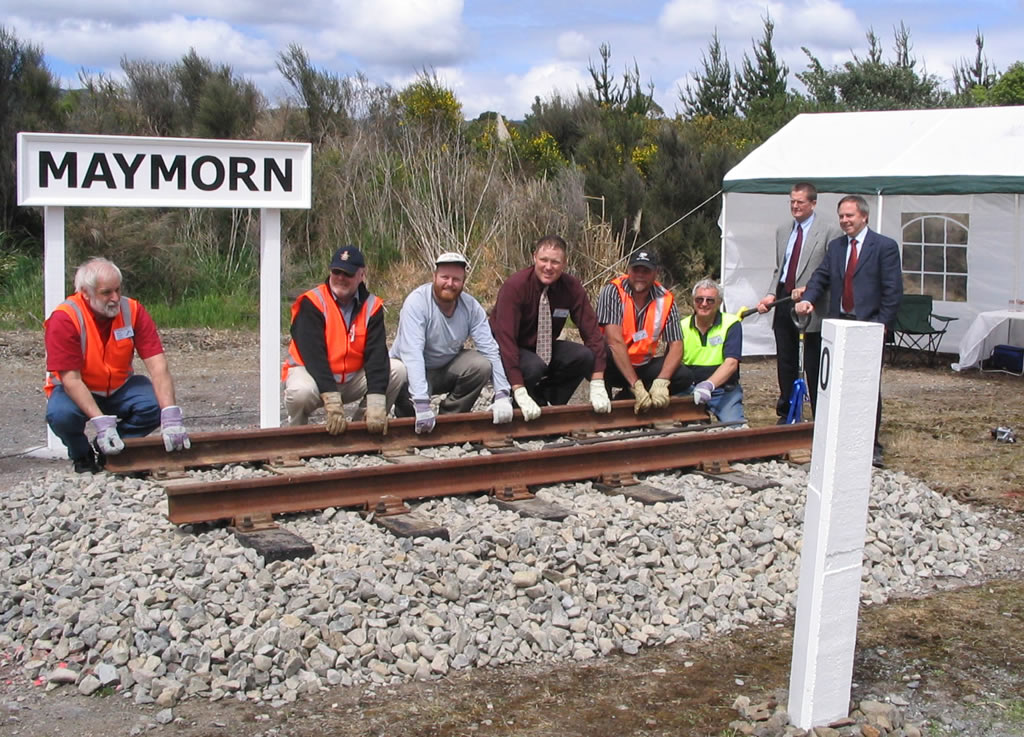
Exactly 50 years since the last train ascended the Rimutaka Incline, the project to reinstate the former route as a heritage railway has been launched. At 11am, Saturday 29 October 2005, the first sod was turned by the Hon. Paul Swain, M.P. for Rimutaka, and Upper Hutt Mayor Wayne Guppy. A first length of track was laid past the ‘zero-peg’ in the Maymorn station yard, where the Trust plans to build a heritage station building, locomotive shed and future operational base for the railway.
Hon. Paul Swain spoke of the potential of the project as a tourist attraction for Upper Hutt and the Wellington region. He proposed to call together representatives from stakeholding organisations in order to drive the project forward. Praise was also given to the Rimutaka Trust for their ongoing support of projects such as the Rimutaka Incline Railway, particularly during the critical startup period.
Mayor Wayne Guppy recognised the potential and significance of the railway project, noting the connection Upper Hutt had with the Rimutaka Incline.
A crowd of nearly 200 people gathered at Maymorn to witness the launch of the Rimutaka Incline Railway. Representatives were present from a number of organisations, including Ontrack, Land Transport New Zealand, Greater Wellington Regional Council, Upper Hutt City Council, New Zealand Railway and Locomotive Society, Mainline Steam Trust, Wairarapa Railway Preservation Society, Marklin Model Railway Club, and Lions Club of Rimutaka, amongst others. Many residents of Upper Hutt, including those from the Te Marua, Maymorn and Mangaroa area also came to the event. Trust members, friends and family also attended.
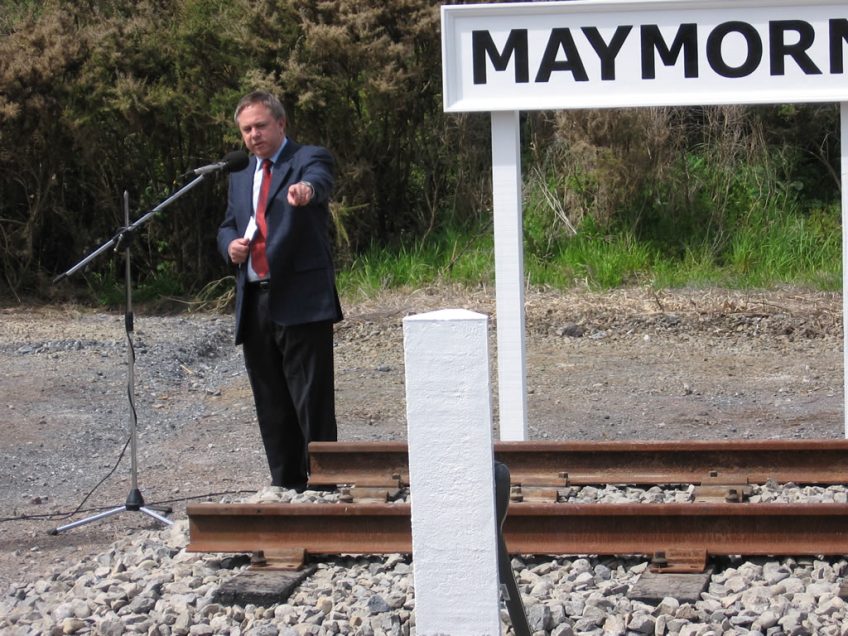
Hon. Paul Swain points out the significance of the zero-peg. Photo: Andy Maciver.
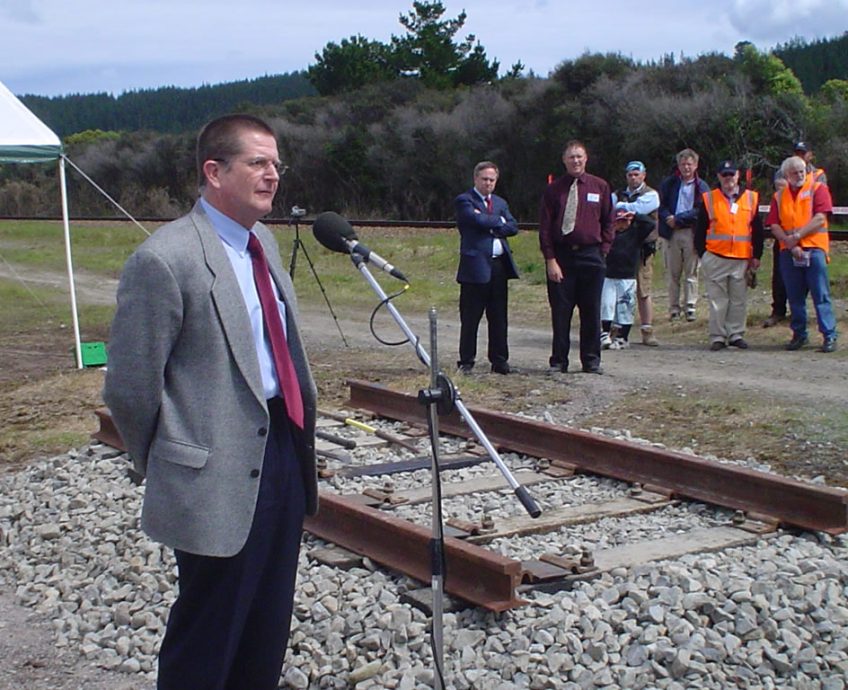
Mayor Wayne Guppy speaking at the launch.
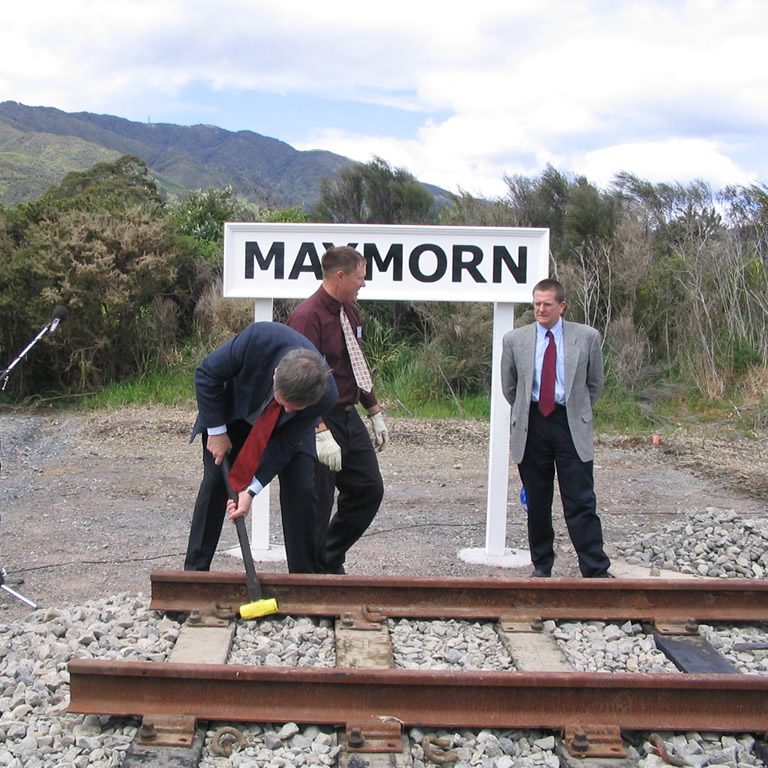
Hon Paul Swain drives home one of the first clips past the 0-km peg. Photo: May Craddock.
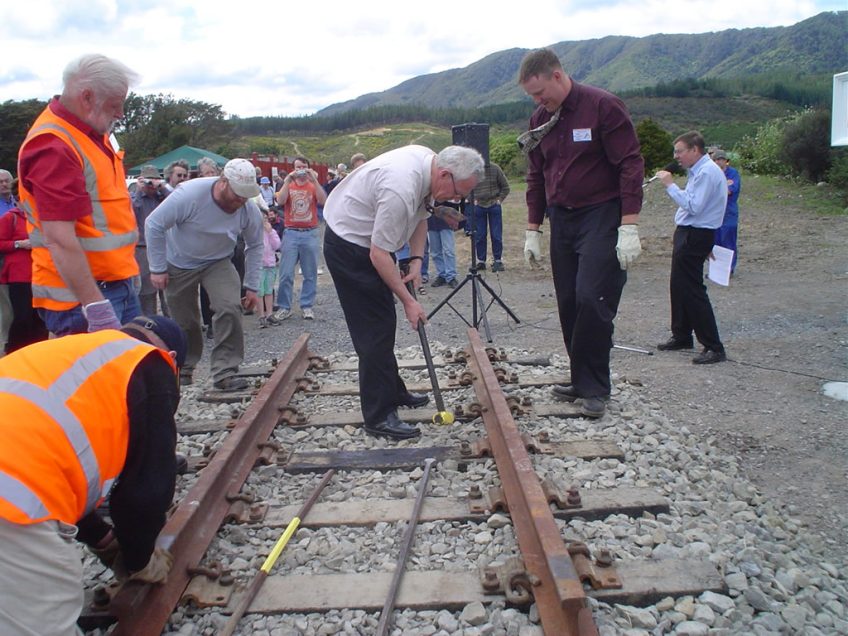
Cr Terry McDavitt, Deputy Chairperson of Greater Wellington Regional Council, drives home clip on first trackset.
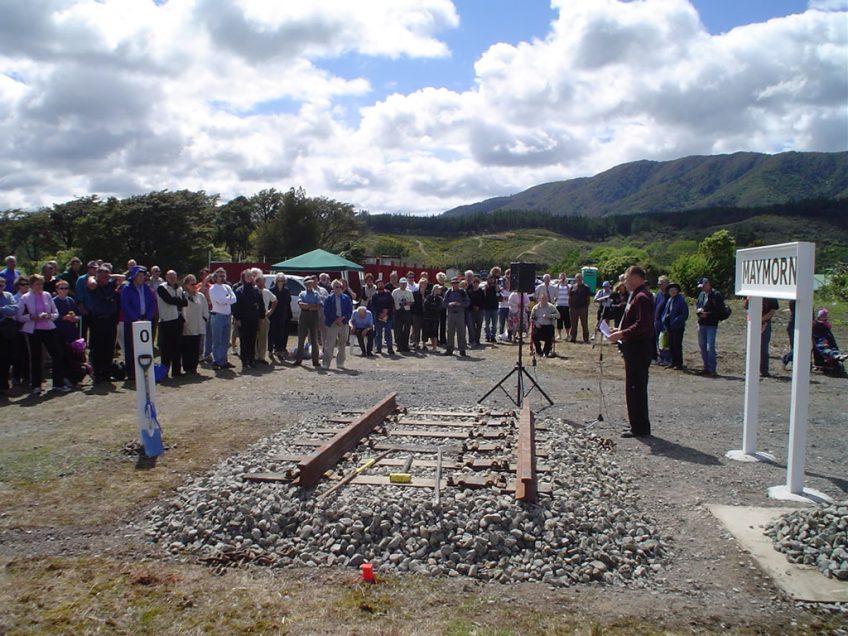
Chairperson Hugh McCracken addressing the crowd during the launch ceremony.
The following is the text of the speech given by Hugh McCracken on the occasion of turning the first sod at the railways launch on 29 October 2005.
Greeting
E nga mana, e nga reo, e nga iwi o te motu, tena koutou, tena koutou, tena koutou katoa. Nga mihi o te tau kia koutou.
Thank you Paul Lambert, for your words of introduction. Welcome to:
- The Honourable Paul Swain, MP for Rimutaka,
- Your Worship Upper Hutt City Mayor Guppy,
- Tangata Whenua, Kaumatua,
- Councillors,
- Ontrack representatives,
- Distinguished guests
- Ladies and Gentlemen.
It is also befitting on this occasion for the following rail heritage organisations of the Wellington region to be acknowledged:
- Friends of the Fell, Featherston
- Silver Stream Railway, also in Upper Hutt City
- New Zealand Railway and Locomotive Society
- Mainline Steam Trust
- Steam Incorporated
- the Wellington Tramway Museum
- Wellington Cable Car
- Wairarapa Railway Preservation Society
Much of our enthusiasm for this project owes a debt of gratitude to these groups.
Welcome
On behalf of the Rimutaka Incline Railway Heritage Trust, I am delighted to welcome you to Maymorn on this most important day, exactly fifty years since the last train ascended the Rimutaka Incline, and some five days shy of the 50th anniversary of the official train that first travelled past this location to the opening ceremony for the Rimutaka Tunnel.
Not only are we marking this anniversary with thoughts of events that occurred in the past, but of what can be achieved in the future.
We think back to early settlers who yearned for a means by which produce from the Wairarapa could be transported through to Wellington, and a means by which the Wellington Province could be linked with the rest of the Island.
The Trust views this route as a connection between Upper Hutt and the Wairarapa, which similarly has the potential to bring economic benefit to the region through its reinstatement as a heritage railway. We turn history on its head, and go back to celebrate what was essentially a bottleneck!
It will also be a link with the past — a means by which we keep our memories alive, a way in which New Zealanders can tell New Zealand stories, and present a unique and significant attraction to the world.
Launch
We are launching Stage 1 of the railway project at Maymorn, on land that has been leased from Ontrack (NZ Railways Corporation). Maymorn gives the Trust the opportunity to “lift the project by a corner”, and to gain a physical presence. It is adjacent to the Masterton railway, and within sight of the heritage route that passes high above the Rimutaka Tunnel.
The Trust plans to operate on Ontrack between Upper Hutt and Maymorn, so that heritage train services can arrive and depart from the city centre. A mainline turnout has been approved in principle, so that trains can come into the Maymorn heritage station, over the Maymorn Road underpass, and thence onto Kaitoke and Summit
What will be built at Maymorn?
The Trust plans to build a replica heritage station building on this site, to a design by George Troup, former Railways Designing Engineer and Mayor of Wellington. We are grateful to the Rimutaka Trust for their financial support for the preparation of architectural drawings and specification.
Conservation architect Chris Cochran is currently working on these detailed plans. We plan to place an information and discovery centre in the station building, along with railway refreshment rooms and our main offices. Maymorn will also be our operational base, with a rail vehicle shed modelled on a heritage engine shed design, located further along the yard.
Recap
This all has to start somewhere, and what better place than the zero-peg. This is located in the middle of the yard throat, through which trains will pass on their journey from Upper Hutt to Summit. Today we will symbolically place track on a piece of formation past the start point, alongside the Maymorn sign, and launch the railway project.
We also remember the following:
- Maori, who had already established tracks linking the Hutt with the Wairarapa, already using what was to become the Rimutaka Hill road, and over what was to become Rochfort’s Pass at Summit;
- Robert Stokes, surveyor working for the NZ Company, first proposing the railway in 1858;
- John Barraclough Fell, when presented with the seemingly impossible task of taking trains over Mt Cenis in France, found a solution in the form of a centre rail, so that steeper gradients could be safely used;
- John Carruthers, Engineer-in-Chief of the Public Works Department, selecting the Fell System;
- Julius Vogel, Colonial Treasurer, who masterminded “think-big mark I”, with a huge programme of public works to provide infrastructure for the country;
- Construction of the line, from 1875, through to openings to Kaitoke on 1 January 1878 and Featherston on 12 October 1878;
- The years between 1923 when a tunnel was first mooted between Mangaroa and Cross Creek, through to 1949, when work started on the Tunnel and Deviation;
- The yard on which we are standing, which is constructed from rock from the Rimutaka Tunnel;
- Morrison Knudsen Limited of San Francisco, teaming up with Downer and Company, who constructed the Rimutaka Tunnel;
- Hon. W.S. Goosman, Minister of Railways, who addressed an assembly in the Maymorn yard on 23 April 1954, three days after the tunnel was holed-through.
- Countless numbers of people who travelled over the old route on the many “last trains”, many of whom are here with us today.
- Prime Minister Right Honourable Sid Holland, opening the deviation on 3 November 1955 at Speedies Crossing.
People who could not make it.
Greater Wellington Regional Councillor Margaret Shields sends her best wishes for the event, noting the potential of the project as a tourist attraction for the Wellington region.
Paul Dillicar, Executive Officer of the Federation of Rail Organisations of New Zealand, who has sent the following note: “You and your team are to be congratulated for the enterprise you are showing, and I am sure you are under no illusions about the enormity of the task you are undertaking. I have a strong desire to ride the RIR, having been too young (11) to have done so before it closed. I wish you and your team every success in bringing this extraordinary World-class project to fruition and would be pleased, if you would extend my greetings to those assembled.”
Those who have helped make this happen
- To Steve Porter, Margaret Shields and Bob Stott, who first mooted the project at Summit during a commemorative ceremony in July 2002;
- Upper Hutt City Council, who have placed a Councillor on the Trust since its inception;
- the Rimutaka Trust, as mentioned earlier, who have supported the project in its formative times;
- To the Trust Board and members, who have worked tirelessly in the weeks heading up to the event.
- Lions club, and Paul Lambert (wearing two hats today), for their efforts in directing people safely to this site, and for catering assistance.
- Thanks to Frazer Tweedie, Mark Gullery and others at Ontrack, with whom we negotiated the lease from enquiry, and engineering considerations through to finality.
The Trust has been looking forward to this day for a considerable length of time, where we symbolically place track past the zero-peg, and officially launch the railway project.
Tena koutou katoa
regards, Hugh McCracken, Chairperson.